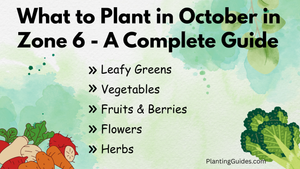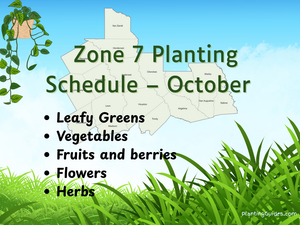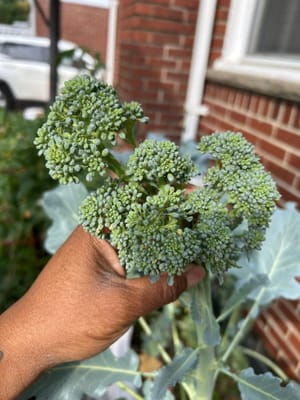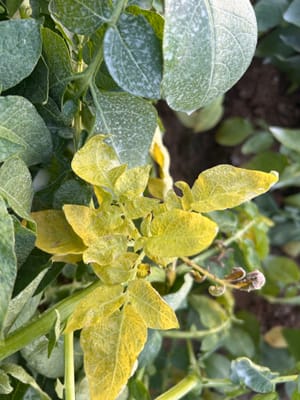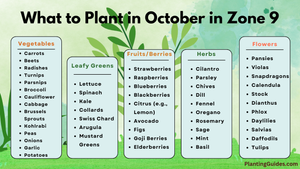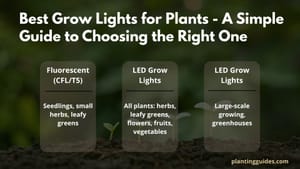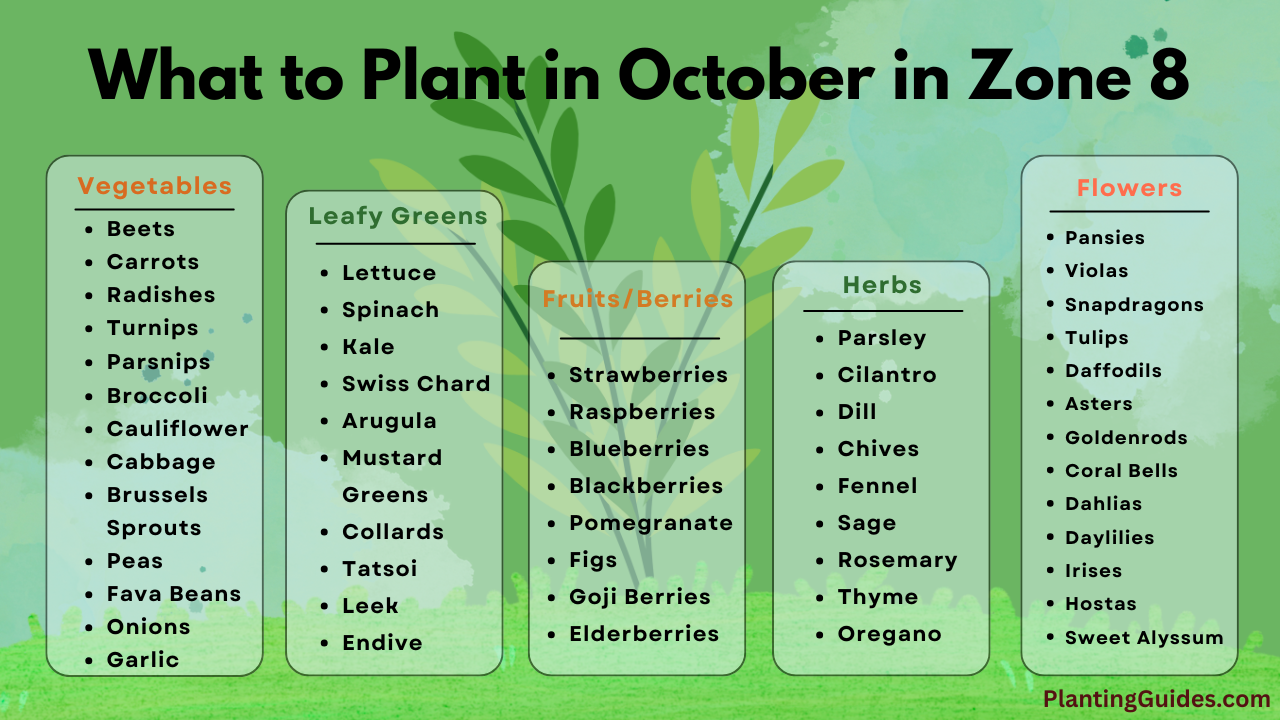
So, finally, it's October in Zone 8. To be honest, October can be a little confusing month for Zone 8 gardeners. Because the summer crops have done, but the winter has not fully arrived yet.
Now, you might think, "Should I just pack up my tools and wait for spring?" But I say, no, not at all! You can grow lots of plants in October.
If you are looking for the plants that grow well in October and give you the best results, then you have landed on the right page.
Just think of this article as your "October cheat sheet" for gardening in Zone 8. I promise, by the time you finish reading this article, you will exactly know which leafy greens, veggies, herbs, flowers, and even fruits & berries grow best in October's cool weather, as well as how to plant them and the best varieties to grow.
Best Leafy Greens to Plant in October
If you want fast results, you can plant lettuce, spinach, arugula, or kale; they all love the cool weather and grow quickly.
And the best thing is, you don't have to wait too long; they will be ready to harvest in just a few weeks.
| Leafy Green | Planting Method | Transplanting Time | First Harvest | Variety Recommendations |
|---|---|---|---|---|
| Lettuce | Direct sow seeds ¼ inch deep | 3–4 weeks after sowing | 45–60 days | Black Seeded Simpson (loose-leaf, bolt-resistant), Buttercrunch (butterhead, tender) |
| Spinach | Direct sow seeds ½ inch deep | Not recommended—sow in place | 40–50 days | Bloomsdale Long Standing (savoyed, cold-hardy), Space (smooth, disease-resistant) |
| Kale | Direct sow or transplant | 4–6 weeks after sowing | 50–65 days | Lacinato (dino kale, nutty flavor), Red Russian (tender, purple stems) |
| Swiss Chard | Direct sow seeds ½ inch deep | 4–6 weeks after sowing | 50–60 days | Bright Lights (colorful stems, kid-friendly), Fordhook Giant (huge leaves, productive) |
| Arugula | Direct sow seeds ¼ inch deep | Not recommended—sow directly | 30–40 days | Astro (mild peppery taste), Rocket (fast-growing, zesty) |
| Mustard Greens | Direct sow seeds ¼ inch deep | 3–4 weeks after sowing | 40–50 days | Southern Giant Curled (spicy, crinkly), Red Giant (mild, colorful) |
| Collards | Transplant seedlings | 4–6 weeks after starting indoors | 60–75 days | Georgia Southern (tender, traditional), Vates (compact, frost-tolerant) |
| Tatsoi | Direct sow seeds ¼ inch deep | 3–4 weeks after sowing | 45–55 days | Standard tatsoi (rosette shape, mild mustard flavor) |
| Leek | Start indoors or direct sow seeds ¼ inch deep | Transplant after 8–10 weeks | 120–150 days | American Flag (heirloom, hardy), King Richard (slender, early-maturing) |
| Endive | Direct sow seeds ¼ inch deep | 3–4 weeks after sowing | 50–60 days | Frisée (curly, crisp), Escarole (broad-leaf, mild flavor) |
As you can see in the above table, Leeks need a long growing season, almost 120 - 150 days. So, start them early in October if you want to harvest them in spring.
The most important thing is Collards are very attractive to cabbage worms and aphids. So, check the undersides of leaves every 2–3 days.
Vegetables to Plant in October in Zone 8
You can confidently grow carrots, beets, radishes, and turnips this October. They like the cool soil, and the colder nights of October actually make them taste sweeter.
These are some of the best vegetables and root crops that you can plant in October in Zone 8.
| Vegetable | Planting Method | Transplanting Time | First Harvest | Variety Recommendations |
|---|---|---|---|---|
| Beets | Direct sow seeds ½ inch deep | Not recommended | 50–60 days | Detroit Dark Red (sweet, reliable), Chioggia (striped, fun for salads) |
| Carrots | Direct sow seeds ¼ inch deep | Not ideal | 60–80 days | Nantes (crisp, no core), Danvers (tapered, stores well) |
| Radishes | Direct sow seeds ½ inch deep | N/A | 20–30 days | Cherry Belle (round, quick), French Breakfast (elongated, mild) |
| Turnips | Direct sow seeds ½ inch deep | 3–4 weeks | 40–60 days | Purple Top White Globe (classic, dual-purpose), Hakurei (sweet, salad-type) |
| Parsnips | Direct sow seeds ½ inch deep | Not recommended | 90–120 days (spring) | All American (long, sweet after frost) |
| Kohlrabi | Direct sow or transplant | 4–6 weeks | 50–60 days | Purple Vienna (colorful, tender), Early White Vienna (mild) |
| Broccoli | Transplant seedlings | 6–8 weeks after starting | 60–90 days | Green Magic (heat-tolerant heads), Packman (early, productive) |
| Cauliflower | Transplant seedlings | 6–8 weeks | 50–80 days | Snow Crown (self-blanching), Amazing (tight curds) |
| Cabbage | Transplant seedlings | 6–8 weeks | 60–100 days | Stonehead (compact, crack-resistant), Golden Acre (early) |
| Brussels Sprouts | Transplant seedlings | 8–10 weeks | 90–110 days | Long Island Improved (classic), Jade Cross (hybrid, uniform) |
| Peas | Direct sow seeds 1 inch deep | N/A | 60–70 days | Sugar Snap (edible pods), Oregon Sugar Pod (snow peas, productive) |
| Fava Beans | Direct sow seeds 1–2 inches deep | N/A | 80–100 days (spring) | Windsor (large beans), Aquadulce (cold-hardy) |
| Onions | Plant sets 1 inch deep | N/A | 100–120 days (spring) | Yellow Granex (sweet), Texas Supersweet (large) |
| Garlic | Plant cloves 2 inches deep | N/A | 180–210 days (summer) | Inchelium Red (softneck, mild), Spanish Roja (hardneck, spicy) |
| Celery | Transplant seedlings | 10–12 weeks | 90–120 days | Utah (tall, crisp), Tango (self-blanching) |
If you want big, beautiful bulbs of garlic and onions next summer, get them in the ground this October. So, they will grow through the winter, and you will get big, beautiful garlic and onions by June or July.
For your kind information, Parsnip germinates very slowly; it usually takes up to 21 days. And you should always start with fresh seed only, old seed won’t sprout well.
Flowers to Grow in Zone 8
October is not only about food, you know—you can plant Cool-season flowers like pansies, violas, snapdragons, and dianthus too.
So, plant them now, and I promise your garden won't be just green this fall.
| Name | Planting Method | First Bloom | Perennial or Annual | Flower Color |
|---|---|---|---|---|
| Pansies | Transplants (nursery seedlings) | Late fall/winter | Annual | Purple, yellow, blue, white |
| Violas | Transplants (nursery seedlings) | Late fall | Annual | Violet, yellow, white, blue |
| Snapdragons | Transplants (from seed or nursery) | Spring | Annual | Pink, red, yellow, white |
| Sweet Alyssum | Direct seeds or transplants | Late fall | Annual | White, pink, purple |
| Tulips (bulbs) | Bulbs | Spring | Perennial | Red, pink, yellow, white |
| Daffodils (bulbs) | Bulbs | Early spring | Perennial | Yellow, white, orange |
| Hyacinths (bulbs) | Bulbs | Spring | Perennial | Purple, pink, white, blue |
| Crocuses (bulbs) | Bulbs | Early spring | Perennial | Purple, yellow, white |
| Asters | Transplants (nursery seedlings) | Fall (next year) | Perennial | Purple, pink, white |
| Goldenrods | Transplants (nursery seedlings) | Fall (next year) | Perennial | Yellow |
| Coral Bells (Heuchera) | Transplants (nursery seedlings) | Spring | Perennial | Red, purple, bronze |
| Dahlias (tubers) | Tubers (plant tubers) | Summer | Perennial (tender) | Red, pink, yellow, white |
| Daylilies | Divisions | Summer | Perennial | Yellow, orange, red, pink |
| Irises | Rhizomes | Spring | Perennial | Purple, blue, yellow, white |
| Hostas | Transplants (nursery seedlings) | Foliage focus, flowers in summer | Perennial | Green, variegated |
| Coneflowers (Echinacea) | Transplants (nursery seedlings) | Summer | Perennial | Pink, purple, white |
| Salvia | Transplants (nursery seedlings) | Spring/summer | Perennial | Blue, purple, red |
You can start Snapdragons and Sweet Alyssum from seeds at home in a seedling tray. As per my experience, you should give them about 4-8 weeks to grow and become strong enough to plant outside.
Fruits & Berries to Plant in Zone 8 in October
I think it's best to plant berries in October. If you plant them in the fall, the plants get enough time to grow strong roots, so they can produce lots of berries in spring.
You can also plant fruits like Figs and Pomegranates this October.
| Fruit/Berry | Planting Method | Plant Height | First Harvest | Variety Recommendations |
|---|---|---|---|---|
| Strawberries | Plant crowns at soil level | 6–12 inches | Spring (next year) | 'Seascape' (everbearing, disease-resistant), 'Chandler' (June-bearing, large fruit) |
| Raspberries | Plant canes 2–3 inches deep | 4–6 feet | Summer (next year) | 'Dormanred' (heat-tolerant), 'Heritage' (everbearing, reliable) |
| Blackberries | Plant roots 2 inches deep | 4–8 feet | Summer (next year) | 'Arapaho' (thornless, early), 'Navaho' (upright, sweet) |
| Blueberries | Plant bushes in acidic soil | 3–6 feet | 2–3 years after planting | 'Sunshine Blue' (low-chill, compact), 'Sharpblue' (rabbiteye, productive) |
| Gooseberries | Plant bushes 4–5 feet apart | 3–5 feet | 1–2 years | 'Hinnonmaki Red' (sweet-tart, mildew-resistant) |
| Elderberries | Plant cuttings or bushes | 6–12 feet | 2–3 years | 'Adams' (large berries), 'York' (productive) |
| Goji Berries | Plant seedlings or cuttings | 8–10 feet | 1–2 years | 'Crimson Star' (vigorous, antioxidant-rich) |
I highly recommend you plant strawberries in raised beds if your soil holds too much water.
I know, you might be thinking about fruits like citrus, apples, or peaches, but in Zone 8, they are better planted in late winter to avoid frost damage to young trees.
Herbs to Grow in Zone 8 in October
If you plan to plant herbs this October in Zone 8, the plants listed below may be the best options for you.
| Herb | Planting Method | Transplanting Time | First Harvest | Variety Recommendations |
|---|---|---|---|---|
| Parsley | Direct sow or transplant | 4–6 weeks | 70–90 days | 'Italian Flat Leaf' (robust flavor), 'Curly' (garnish queen) |
| Cilantro | Direct sow seeds 1/4 inch deep | Not recommended | 45–70 days | 'Santo' (slow to bolt), 'Calypso' (productive) |
| Dill | Direct sow seeds 1/4 inch deep | Not ideal | 40–60 days | 'Bouquet' (tall, for pickling), 'Fernleaf' (compact) |
| Chives | Transplant clumps | N/A | 60 days | Common chives (mild onion), 'Garlic' (garlicky twist) |
| Fennel | Direct sow or transplant | 4–6 weeks | 80–100 days | 'Florence' (bulb type), 'Bronze' (feathery, ornamental) |
| Sage | Transplant seedlings | N/A | 75 days | 'Common' (gray-green, versatile), 'Pineapple' (fruity scent) |
| Rosemary | Transplant cuttings | N/A | 80 days | 'Arp' (cold-hardy), 'Tuscan Blue' (upright) |
| Thyme | Transplant | N/A | 70 days | 'English' (culinary staple), 'Lemon' (citrusy) |
| Oregano | Transplant | N/A | 80 days | 'Greek' (spicy), 'Italian' (mild) |
Plant what you actually use. No one needs 20 types of thyme. If you have a few fast growers like cilantro and basil, plus hardy perennials like oregano and rosemary, that's the perfect combo for your October garden.
